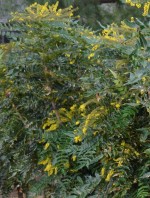 This large, gangly evergreen shrub is a native of China but grows especially well in southern United States where it is sometimes considered invasive. It is a member of the barberry family, V, that also includes nandina, bishop’s hat, and mayapple. The plant is upright and loose, and has large pinnately compound leaves up to twenty-four inches long. Each leaf has nine to fifteen widely spaced dark olive green leaflets that are shiny, prickly and resemble holly leaves. In late winter pale yellow scented flowers are produced in erect, three to six inches long, terminal racemes that give way to clusters of small bluish black fruits in late summer. With the proper pruning this coarse textured plant and can have an exotic look and add structural interest to the garden especially when planted against a wall. Leatherleaf mahonia likes afternoon shade in hot climates and is useful in foundation plantings, mixed borders, hedges, screens, and informal plantings. The genus name, Mahonia, honors Bernard McMahon (1775-1816) one of the stewards of the plant collections from the Lewis and Clark Expedition and author of The American Gardener’s Calendar (1806). The specific epithet, bealei, probably honors Thomas Beale(c. 1775–1841), Scottish naturalist.
This large, gangly evergreen shrub is a native of China but grows especially well in southern United States where it is sometimes considered invasive. It is a member of the barberry family, V, that also includes nandina, bishop’s hat, and mayapple. The plant is upright and loose, and has large pinnately compound leaves up to twenty-four inches long. Each leaf has nine to fifteen widely spaced dark olive green leaflets that are shiny, prickly and resemble holly leaves. In late winter pale yellow scented flowers are produced in erect, three to six inches long, terminal racemes that give way to clusters of small bluish black fruits in late summer. With the proper pruning this coarse textured plant and can have an exotic look and add structural interest to the garden especially when planted against a wall. Leatherleaf mahonia likes afternoon shade in hot climates and is useful in foundation plantings, mixed borders, hedges, screens, and informal plantings. The genus name, Mahonia, honors Bernard McMahon (1775-1816) one of the stewards of the plant collections from the Lewis and Clark Expedition and author of The American Gardener’s Calendar (1806). The specific epithet, bealei, probably honors Thomas Beale(c. 1775–1841), Scottish naturalist.
Type: Flowering evergreen shrub
Outstanding Features: Foliage, flowers
Form: Upright, loose, vase-shaped; gangly; informal
Growth Rate: Moderate
Bloom: Pale yellow scented flowers are produced in erect, 3-6″ terminal racemes in late winter; small bluish black fruits are produced in cluster by late summer.
Size: 4-10′ H x 3-8′ W
Light: Afternoon sun in the South; full sun to partial shade in zone 7 and colder
Soil: Organically rich, moist, well-drained,acidic
Hardiness: Zones 6-10
Care: Prune out a few stems each spring after flowering to encourage fresh growth.
Pests and Diseases: None of significance
Propagation: Fresh seed; cuttings.
